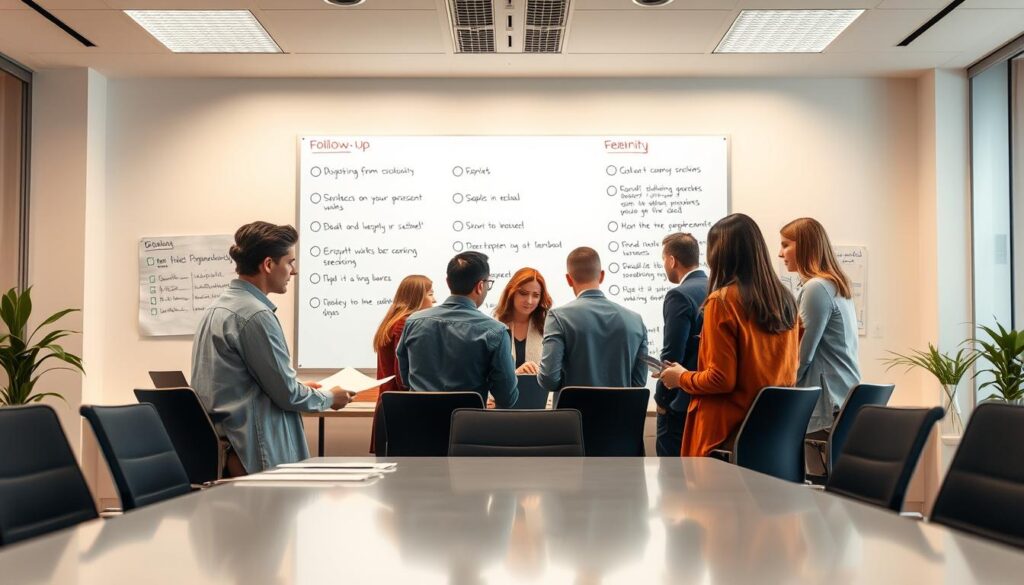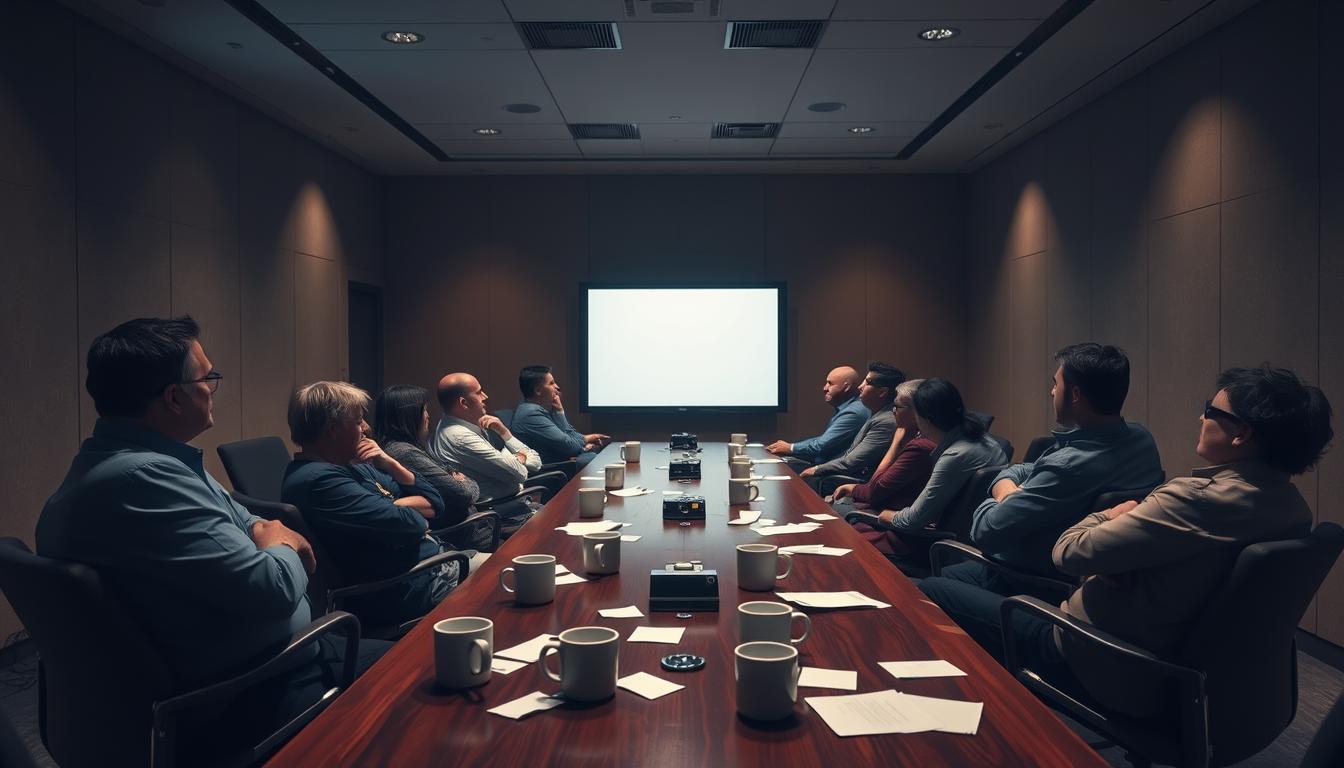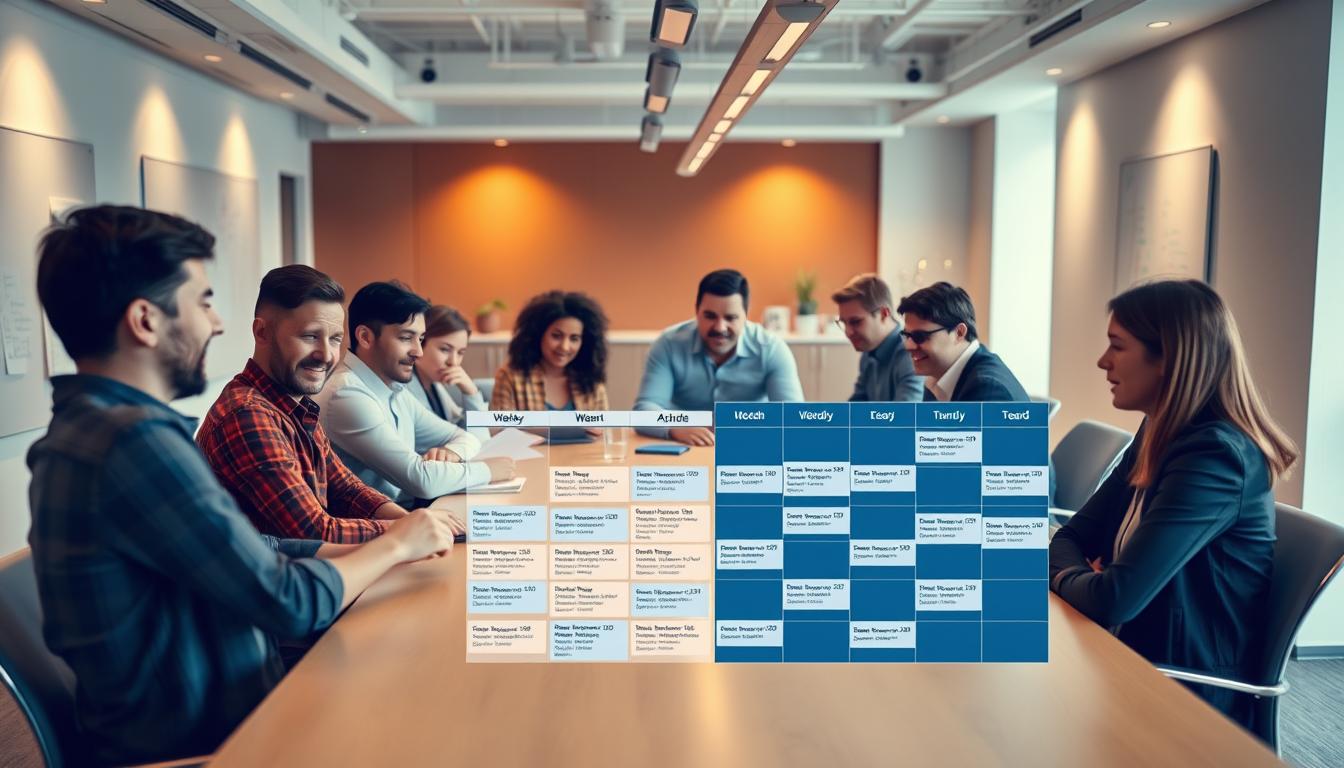In today’s fast world, cutting down meeting time is seen as vital for boosting work productivity. Long meetings often make workers less happy and engaged. This shows the pressing need to make meetings better and more efficient.
By using smart strategies, groups can make their talks clearer and shorter. This helps achieve better results and makes meetings more productive.
Understanding the Importance of Reducing Meeting Time
Organizations today struggle with time management, especially with more meeting hours. Studies show high-level executives spend about 23 hours a week in meetings. This is a big jump from less than 10 hours back in the 1960s. Such an increase leads to meeting tiredness among staff. This hurts both how much they get done and their balance between work and life.
Impact on Productivity
Too many meetings cut down on important work time. This can cause workers to feel overwhelmed and less productive. They have a hard time keeping up with their main tasks. This slows down project work and lowers how well the workplace runs.
This situation can make it hard for creativity and drive to grow.
The Rise of Meeting Fatigue
More frequent and longer meetings can leave employees feeling tired and less interested. Meeting tiredness happens when they see these gatherings as pointless or not well-planned. This makes their work-life balance even harder to maintain.
Cutting down on meeting time can make employees happier. It can help bring energy back to teams, making the whole company do better.
Identifying Common Pitfalls in Meetings
Meetings often stumble due to obstacles that stop them from being productive. Spotting these common issues is key to holding better meetings. When there’s too much on the agenda, topics can overlap, causing confusion. This makes it tough to meet our goals.
Over-scheduling and Overlapping Discussions
Packing meetings with topics or having discussions crash into each other slows everyone down. It splits conversations and blocks chances to work together. To fix this, teams need to figure out what’s most important. That way, every topic gets the focus it needs.
Unclear Objectives and Agendas
Vague agendas with no clear goals are another big problem. Without set aims, we end up talking in circles and wasting time. Clear goals help everyone stay on track and manage meetings better. Having an agenda that shows what we’ll talk about and what we hope to achieve keeps the conversation going in the right direction. This boosts our productivity.
Strategies to Reduce Meeting Time
Making meetings more effective can greatly improve how a team works together. Start by setting clear goals before any meeting and choose the best tech to help organize it. Doing this saves time and keeps everyone involved and paying attention.
Setting Clear Objectives Before Meetings
Having clear goals for each meeting is crucial. When everyone knows what the meeting is about, they can come prepared. This makes sure the meeting stays on track and makes the most out of the time spent.
Utilizing Technology for Scheduling
Using modern tech to schedule meetings makes organizing easier for everyone. Tools that work with your calendar and avoid double bookings make planning smooth. It cuts down on unnecessary emails and makes meetings more effective.
The Role of Agile Principles in Meeting Efficiency
Adding Agile principles to how we meet makes things way more efficient. This idea makes sure meetings are useful to everyone there. It also makes face-to-face talks a big deal. When people talk directly, they work better together and get distracted less. Agile gets everyone to talk about what really matters, making things more productive.
Emphasizing Face-to-Face Communication
Having chats in person or on video is key in Agile methods. This lets people share thoughts and get replies right away. Avoiding long emails or chat messages stops confusion. Talking directly also sparks quick ideas and solutions. This fits perfectly with what Agile wants.
Keeping Meetings Relevant to Attendees
Agile also means making sure the right people are in meetings. This keeps the talk focused and avoids off-topic stuff. It makes sure everyone is really into the discussion and responsible. Using Agile helps use time wisely and makes everyone’s input better.
Implementing Standup Meetings
Standup meetings, or daily huddles, streamline project updates for the team. These quick meetings help everyone share updates on their work. It’s a great way for the team to stay on track each day.
Benefits of the Daily Standup
Daily standup meetings are really helpful because they:
- Boost teamwork by checking in regularly
- Make sure everyone is doing their part
- Keep the meeting short, so people stay focused
Encouraging Punctuality Through Time Constraints
Limiting meeting time makes everyone more punctual. Knowing they have to stand and talk briefly, team members show up on time. This helps the meeting stay productive and shows respect for everyone’s time.
Keeping Meetings Focused and Relevant
Meetings work best with a good plan. This includes making clear agendas that list everything that will be talked about. It helps everyone know what to expect. And it lets them give better input during the meeting.
Creating a Clear Agenda for Each Meeting
It’s really important to prepare an agenda for every meeting. An agenda acts like a map for the meeting, showing the goals. It makes sure communication is smooth and keeps everyone on the same page. This leads to more effective meetings.
Designating Time Slots for Each Topic
Setting aside specific times for each item on the agenda makes meetings run better. It makes sure everyone tries to stick to the topic in the time given. By following this rule, discussions are more likely to stay on point. This helps avoid wasting time on unrelated things.
Innovative Meeting Formats to Save Time
Teams searching for efficient meetings will find innovative formats very helpful. Engaging methods keep everyone focused and encourage working together. By using the Koosh Ball method and visual aids, meetings become more productive and interactive.
Using the ‘Koosh Ball’ Method for Engagement
The Koosh Ball method makes meetings come alive. Participants toss a Koosh ball to decide who speaks next. This ensures everyone gets a turn, preventing a few from taking over the conversation. It keeps discussions lively and everyone involved.
Visual Aids and Task Boards to Streamline Discussions
Visual aids can make meetings clearer for everyone. Tools like charts or slides help explain complicated info. Task boards show what needs to be done, helping everyone understand their tasks. These tools make meetings more focused and goal-oriented.
Encouraging Sprints to Enhance Meeting Efficiency
Adding project sprints to your work can make meetings much better. By splitting big tasks into smaller parts, teams can talk about specific goals. Each sprint needs clear goals and a fixed time, making sure everyone stays interested and works well.
Defining Incremental Steps for Projects
Setting small steps helps teams see their progress. It’s easier to understand goals and deadlines with smaller tasks. Having meetings about these steps can make talks more focused, cut down on wasted time, and keep everyone on the right path.
When teams focus on sprints, they move forward faster. This method cuts down on distractions and keeps everyone focused, leading to better talks. Meetings become more useful, which means they get more done.
Establishing Follow-Up Procedures
Having good follow-up steps is key after meetings. It’s how ideas turn into real results. A set plan for who does what makes everyone responsible and helps get things done. Teams can work better, knowing exactly their tasks from meeting talks.
Assigning Action Items Post-Meeting
Clear tasks given out in meetings make everyone know their next steps. Every job needs a clear description and the right person to do it. This keeps work flowing and the team focused.
- Outline specific tasks and objectives for each action item.
- Assign a responsible party to ensure accountability.
- Establish deadlines to maintain momentum on meeting outcomes.
These steps help teams keep track and quickly tackle any issues. Talking about what everyone needs to do emphasizes how crucial everyone’s work is. It strengthens the team’s drive to reach shared goals.

Measuring the Effectiveness of Reduced Meeting Time
To really know how cutting back on meeting time helps, organizations should look at different ways to measure this. It’s very important to ask team members what they think. This can help figure out what’s working well and what’s not in their meetings. With this insight, they can make meetings better and more useful for everyone.
Gathering Feedback from Team Members
Getting feedback from team members is key to knowing if meetings are any good. Teams might want to use surveys or just talk to get people’s opinions. They should ask if meetings are useful and if they are meeting their goals. This feedback helps see what’s doing well and what needs to get better.
Analyzing Time Saved vs. Productivity Gains
Looking at how much time is saved versus how much more work gets done can show if shorter meetings are working. Organizations can look at how much work gets done before and after they change how they do meetings. They can track things like how quickly projects are finished and how happy employees are. This can really show how changing meetings affects work.
Conclusion
Today’s work world moves fast, making it crucial to cut down meeting times. We can do this by setting clear goals, using tech smartly, and keeping talks relevant. These steps help make meetings more efficient. This not only makes communication smoother but also boosts work productivity and makes employees happier.
Long meetings can make team members feel tired and less excited. But, with fresh meeting styles and strong follow-up plans, we can make everyone value time more. As work changes, using smart strategies can help companies stay ahead. This way, they can reach their goals more effectively.
At its core, using less meeting time helps everyone do better work. When we embrace these strategies, companies can handle big projects easier and respond to market needs quickly. This ensures they can succeed now and in the future.



